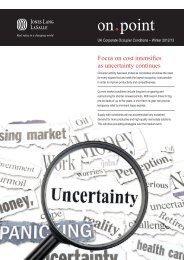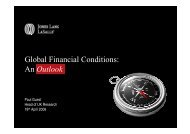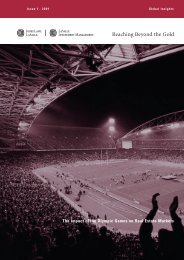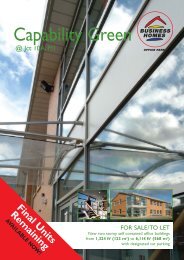An Achievable Goal - Jones Lang LaSalle
An Achievable Goal - Jones Lang LaSalle
An Achievable Goal - Jones Lang LaSalle
You also want an ePaper? Increase the reach of your titles
YUMPU automatically turns print PDFs into web optimized ePapers that Google loves.
Strategic Consulting: <strong>An</strong> <strong>Achievable</strong> <strong>Goal</strong>, May 2002<br />
Photograph by Reuters<br />
abc<br />
<strong>An</strong> <strong>Achievable</strong> <strong>Goal</strong><br />
Stadiums, Arenas and Urban Regeneration<br />
1<br />
abc<br />
May 2002
Strategic Consulting: <strong>An</strong> <strong>Achievable</strong> <strong>Goal</strong>, May 2002<br />
<strong>An</strong> <strong>Achievable</strong> <strong>Goal</strong><br />
Stadiums, Arenas and Urban<br />
Regeneration<br />
May 2002<br />
Roger Hobkinson<br />
Strategic Consulting<br />
<strong>Jones</strong> <strong>Lang</strong> <strong>LaSalle</strong><br />
2<br />
abc
Strategic Consulting: <strong>An</strong> <strong>Achievable</strong> <strong>Goal</strong>, May 2002<br />
Executive Summary<br />
! On their own, stadia are unlikely to underpin regeneration goals, and should be viewed as<br />
part of a holistic approach to mixed use regeneration. Of fundamental importance is the need<br />
for any stadium or arena to have a sustainable business model. When this is delivered such<br />
an iconic building can be a powerful catalyst for destination and value creation, which over<br />
time, can be expected to meet regeneration aspirations.<br />
! With uncertainty over the specific and viable longer-term business operations of the stadiums<br />
for the World Cup 2002, we remain unconvinced that the mechanisms are yet in place for the<br />
World Cup to have a widespread and enduring regeneration effect.<br />
! The lessons learnt this year in Japan and South Korea and from past sporting events, will<br />
highlight what this means for the towns and cities that host future major sports events. For<br />
example the approach of the host cities in Euro 2004 in Portugal and World Cup 2006 in<br />
Germany.<br />
! Closer to home with much of UK Club Football experiencing severe financial problems, we<br />
expect clubs and their partners, such as local authorities, to further focus on the positive role<br />
stadiums can play in their businesses and communities.<br />
3<br />
abc
Strategic Consulting: <strong>An</strong> <strong>Achievable</strong> <strong>Goal</strong>, May 2002<br />
Introduction<br />
For four weeks this June the eyes of the world will be on Japan and South Korea as they host the<br />
Football World Cup. Equally as dazzling as the skills of Zidane, Figo, Beckham and Ronaldo will<br />
be the stadia.<br />
<strong>Jones</strong> <strong>Lang</strong> <strong>LaSalle</strong>’s Strategic Consulting team advise on some of the World’s largest mixed use<br />
development schemes, frequently incorporating stadiums, arenas or other such iconic buildings.<br />
Below we provide a commentary on the framework needed for stadiums and arenas to<br />
successfully contribute towards urban regeneration aspirations and generate positive real estate<br />
impacts.<br />
“If you build them they will come”<br />
In the late 1980’s and throughout the 1990’s there was an increased recognition amongst<br />
business and city authorities of the value, sometimes quantifiable other times not, of sports<br />
stadiums as a tool for urban regeneration. Increasingly major sports facilities are seen as a<br />
mainstay of urban regeneration and city repositioning aspirations. This is driven by a city’s desire<br />
to raise its profile, make a step change in external and internal perceptions of itself and improve<br />
its real estate product in an attempt to attract business and people and become a winning city.<br />
On their own such iconic buildings are unlikely to underpin regeneration goals, but as part of a<br />
holistic approach to mixed use development can provide a powerful catalyst for value creation<br />
and thus urban regeneration. Key factors that should be considered when incorporating a<br />
stadium into an area for mixed-use regeneration include:<br />
The urban and economic context<br />
! This sets limits and identifies what the possible achievements might be.<br />
A defined vision and master-plan<br />
! What type of place is the location going to be and is there a “route map” of how to achieve<br />
this?<br />
Demand forces<br />
! Where would demand come from in the future and how could the location best align with<br />
these trends?<br />
Transportation<br />
! This will have a major impact upon the scale and nature of demand.<br />
4<br />
abc
Strategic Consulting: <strong>An</strong> <strong>Achievable</strong> <strong>Goal</strong>, May 2002<br />
Competitive context<br />
! How does the location compare to other locations, what is the positioning in terms of city<br />
authorities and landowners.<br />
Real Estate Product<br />
! What type of residential, office, leisure and retail concepts could be introduced? Would these<br />
align with demand trends and offer synergistic value with the stadium. Furthermore what<br />
branding opportunities are there?<br />
Development Structure<br />
! What are the alternate joint venture structures that might be considered.<br />
Credibility, Deliverability and Sustainability<br />
Of fundamental importance in any arena, stadium, or cultural development is the need for a<br />
credible, sustainable and deliverable business model. When this element is missing value is<br />
unlikely to be created hitting long run regeneration aims. However when such buildings are<br />
considered as part of a holistic package, destination and value creation are likely to be achieved,<br />
delivering a powerful connection between business, city authorities and communities.<br />
City authorities clearly have numerous roles to play in meeting stadium development and<br />
regeneration goals. One significant influence city authorities have is how they view different uses<br />
that may or may not have synergies with the stadium. This is important, as it is likely to determine<br />
whether or not the stadium business model is sustainable. <strong>An</strong> enlightened city authority which<br />
adopts a flexible approach, within its planning framework, to uses that have synergies or are<br />
perhaps ancillary to the stadium is likely to see stadium wins. Such as:<br />
Destination Creation<br />
! From low value brownfield land to a vibrant neighborhood with increased footfall and potential<br />
24/7 operation.<br />
Quality of life<br />
! Community pride and provision of leisure and community facilities.<br />
Exposure<br />
! Unquantifiable value through the projection of a “place”.<br />
Economic<br />
! Raising of real estate values will provide the opportunity to attract higher value uses<br />
generating new employment opportunities, for example, by capturing the sports tourism £, $,<br />
€, Y etc.<br />
5<br />
abc
Strategic Consulting: <strong>An</strong> <strong>Achievable</strong> <strong>Goal</strong>, May 2002<br />
Critical mass<br />
! Opportunity to capture the fusion of leisure, entertainment and retail uses to meet heightened<br />
consumer expectations – “it’s about experience”.<br />
Japan and South Korea 2002<br />
Cities in both Japan and South Korea have developed stunning new stadiums and in some cases<br />
done so with urban regeneration and economic development in mind. The South Korean<br />
organisers are in little doubt that the regeneration impact of the World Cup will be large. In the<br />
summary document which outlines their expectations of the World Cup, they stated that the new<br />
stadiums would act as a magnet for investment and regeneration in the 10 host cities. They<br />
expect the stadia “to become tourist attractions in their own right, not only for their facilities but<br />
also as outstanding and original works of architecture”. The organisers state that the various<br />
stadia will be re-developed after the World Cup tournament to include multi-media cinemas,<br />
swimming pools, restaurants, hypermarkets and sporting goods outlets.<br />
Whether or not these concepts have a sound business model to ensure delivery and<br />
sustainability is currently difficult to ascertain. What is clear is that advances in recent years have<br />
seen the development, technological and operational risks of multi-purpose stadiums reduce.<br />
This means that a broader range of facilities and activities can be accommodated thus raising the<br />
possibility of delivering a sustainable business model.<br />
In hoping that the World Cup will provide such widespread regeneration benefits the 2002<br />
organisers are, to a large extent, treading new ground. In contrast to the Olympics, which have<br />
often been used as a catalyst for regeneration on a larger scale the only significant example of<br />
the World Cup being used in this way is the Stade de France in St Denis, Paris (see Case Study<br />
section).<br />
Similar hopes have been expressed by both the Japanese organisers and local governments who<br />
bid keenly in a series of domestic competitions for the right to host matches. In Japan, local<br />
governments even got embroiled in highly complex and highly expensive competitions for the<br />
right to host team training camps for the duration of the World Cup.<br />
Despite the positive example from the last World Cup, our research suggests it is unlikely that the<br />
long-term regeneration impact on the 2002 hosts will be significant. The 2002 tournament is<br />
spread widely between two nations and over 20 host cities – the largest number of different<br />
locations ever used for the World Cup. This means most cities host a maximum of three or four<br />
matches and these are often day visits from the major cities. Therefore there is no concentrated<br />
impact on any one city for the month of the World Cup and at the end of the tournament there is<br />
no specific real estate legacy other than the actual stadium. This is a contrast to the Olympic<br />
Games where the impact on one location is more intense as illustrated by the example of<br />
Stadium Australia (see Case Study section).<br />
Furthermore, in general, the 2002 World Cup has avoided venues in major cities. For instance,<br />
the largest Japanese cities to host any games are Osaka and Yokohama with no games held in<br />
Tokyo. Though Seoul is being used as the centre-piece of the event in South Korea, a number of<br />
smaller locations will also host matches. It is these smaller, less economically developed areas<br />
6<br />
abc
Strategic Consulting: <strong>An</strong> <strong>Achievable</strong> <strong>Goal</strong>, May 2002<br />
that are hoping for the biggest regeneration boost. However, it is these areas that we suspect<br />
may be the most disappointed.<br />
In Japan and South Korea the new facilities generally appear to show questionable business<br />
plans for post-World Cup use. There are a large number of broad plans such as the “multipurpose<br />
cultural centre” planned for the Suwon World Cup Stadium in South Korea. However<br />
comparing these plans to the key factors necessary for successful regeneration we suspect that<br />
key issues such as the urban and economic context, demand forces and the competitive context<br />
for the city have been neglected.<br />
Saitama – The 2002 Winner ?<br />
A notable exception to this appears to be Saitama in Japan where the Saitama Stadium 2002 will<br />
form part of a new urban development project. Called the Saitama New Urban Centre and<br />
covering a total area of nearly 50 hectares, the masterplan includes the cities of Urawa, Omiya<br />
and Yono. The project aims to create a new urban zone with a surface area of 1.8 m² providing<br />
potential employment for around 60,000 people. The urban context appears to have been fully<br />
considered. The proposed development (located 24 km north of Tokyo) will play an important<br />
role in the reorganisation of the Greater Tokyo metropolitan area and is aimed at helping alleviate<br />
problems caused by an excessive concentration of urban facilities in the central district of the<br />
national capital. A new express highway and a brand new railway station are being built to<br />
provide efficient access to the new urban centre.<br />
Future Implications<br />
Going forward it will be interesting to see how Portuguese and German cities seek to use the<br />
2004 European Championships and 2006 World Cup respectively as a tool for regeneration. As<br />
highlighted Japan and South Korea have very much “started from scratch”, in constructing state<br />
of the art stadiums. With football much more culturally ingrained and a broad range of existing<br />
stadia in Portugal and Germany, stadium construction will not be on the scale seen in Japan and<br />
South Korea. However we feel that where new stadiums are proposed in Lisbon, Porto, Aveira,<br />
Bragga and Faro (Portugal) and Hamburg, Leipzig, Frankfurt and Munich (Germany) the city<br />
fathers will be keen to incorporate these stadiums into regeneration projects.<br />
Elsewhere in Europe, Scotland and the Republic of Ireland at the end of May 2002 are due to<br />
submit a combined bid for the 2008 European Championships. Clearly in terms of stadiums,<br />
regeneration and property opportunities the thoughts highlighted in this report will equally apply.<br />
In the case of UK club football, problems with TV rights and spiraling wage costs are forcing clubs<br />
to undertake a fundamental review of their business models. Football clubs and their joint<br />
venture partners will look to their stadiums to play an increasingly central role in their business<br />
generation. Recent developments at: Bolton - The Reebok Stadium, Sunderland - The Stadium<br />
of Light and proposed developments for Arsenal, Manchester City, Liverpool and Everton, being<br />
indicative of the role stadiums can have in regeneration, property development and community<br />
engagement.<br />
7<br />
abc
Strategic Consulting: <strong>An</strong> <strong>Achievable</strong> <strong>Goal</strong>, May 2002<br />
Case Studies<br />
Stade De France, St Denis, Paris<br />
The Stade de France has helped to breath new life into a traditional industrial and increasingly<br />
rundown suburb of northern Paris. Built for the 1998 World Cup, the Stade de France is now<br />
the home of French football and rugby teams and also provides one of Europe’s largest<br />
athletics venues. In addition to the headline grabbing sports events, a variety of one off events<br />
combined with ancillary leisure, retail and business facilities have added to the vitality of the<br />
area. In tandem with the development of metro and RER rail links, the Stade de France has<br />
helped to reposition St Denis for the 21 st century. The improved environment and vitality of the<br />
area has seen St Denis start to register as a significant suburban office location, with a major<br />
increase in the development pipeline.<br />
Stadium Australia, Homebush, Sydney<br />
Developed on the site of a former munitions facility, brick works and abattoir the Homebush<br />
area now boasts one of the largest and best serviced residential communities in Sydney.<br />
Located 12 km from downtown Sydney, Stadium Australia was the centre-piece of the stunning<br />
2000 Olympics. The masterplan for the 40ha site not only included the stadium and<br />
associated facilities but provision of 1,200 residential units and associated retail, leisure and<br />
community facilities (which are largely complete) to cater for an eventual population of over<br />
5,000.<br />
Since the Olympic Games, Stadium Australia has been remodeled to accommodate a broader range of<br />
sports and one off events that includes: Rugby League and Union, Australian Rules Football, Soccer,<br />
Cricket and American Football.<br />
8<br />
abc
Strategic Consulting: <strong>An</strong> <strong>Achievable</strong> <strong>Goal</strong>, May 2002<br />
Jeju Island, South Korea<br />
Strategic Consulting advised on a leisure led mixed use development on Jeju Island, leading<br />
an economic development strategy to position the Island as a "free international city" based on<br />
tourism, logistics and financial services. Strategic Consulting’s recommendations related to an<br />
integrated tourism strategy to broaden the international appeal of the island. This includes<br />
developing a program of year round events many of which could take advantage of the new<br />
Jeju World Cup stadium, that FIFA consider to be one of the most stunning in the world. After<br />
the World Cup is over the stadium facilities will include a cultural and tourist exhibition centre, a<br />
tourist information centre, IMAX cinema, food court and aquarium.<br />
Strategic Consulting’s efforts appear to be have been highly regarded by Sven Goran Eriksson<br />
and the England squad. Prior to the World Cup, David Beckham, Michael Owen et al have<br />
been based on the island, taking advantage of the world class sports and leisure facilities the<br />
island now offers.<br />
The Millennium Dome, Greenwich, London<br />
The UK Government advised by Strategic Consulting, has signed heads of terms and expects to shortly<br />
conclude the transaction with an international consortium to secure a world class future for the<br />
Millennium Dome and the Greenwich Peninsula.<br />
The consortium, Meridian Delta Limited comprises Lend Lease Corporation (Australia), Quintain<br />
Estates and Development (UK) and the <strong>An</strong>schutz Entertainment Group (USA). <strong>An</strong>schutz will provide a<br />
20,000 capacity state of the art arena inside the Dome, along with leisure and entertainment facilities.<br />
Lend Lease and Quintain, in a joint venture with English Partnerships (a UK Government regeneration<br />
agency), will regenerate 76 ha of land for over 1 million m² of residential, office, retail and community<br />
space and so creating a comprehensive new quarter for London.<br />
9<br />
abc
Strategic Consulting: <strong>An</strong> <strong>Achievable</strong> <strong>Goal</strong>, May 2002<br />
Wembley, London<br />
A commentary on stadiums and what they can mean for cities would not be complete without a<br />
mention of probably the worlds’ most famous stadium. There are many reasons why the<br />
redevelopment of Wembley into a venue befitting London’s leading global city status has been<br />
delayed. What is clear is that without it London is missing a significant element of its real<br />
estate product offer and is arguably losing out on the unquantifiable profile that such an iconic<br />
building offers. The successes of Stadium Australia, the Stade de France, Millennium<br />
Stadium, Cardiff, have illustrated how stadia can help in the regeneration, positioning and<br />
branding of a city.<br />
Within a London context, the Mayor of London argues:<br />
“The new stadium is vital for the economic regeneration of Northwest London, which has<br />
suffered some of the highest levels of deprivation in the country, with unemployment running at<br />
twice the national average.”<br />
10<br />
abc
Strategic Consulting: <strong>An</strong> <strong>Achievable</strong> <strong>Goal</strong>, May 2002<br />
Strategic Consulting<br />
<strong>Jones</strong> <strong>Lang</strong> <strong>LaSalle</strong>’s Strategic Consulting team continue to be involved in new development<br />
concepts that establish destinations, including many regeneration schemes that incorporate a<br />
stadium or arena component. Our key role being to articulate the development and asset<br />
strategy and what this means in terms of urban regeneration and real estate opportunities.<br />
Our track record includes:<br />
Earls Court Olympia Arena – London, Galgenwaard Stadium – Utrecht; Chicago Bears –<br />
Chicago; Melbourne Docklands & Colonial Stadium, Stade de France – Paris, Wembley –<br />
London, Jeju Island – South Korea, Millennium Dome & Greenwich Peninsula – London, Kings<br />
Dock – Liverpool, Aquatic Stadium – Hong Kong, Eastlands Development & Commonwealth<br />
Games Facilities – Manchester, Lambton Harbour - Wellington, Plaz Merdeka – Kuala Lumpur.<br />
Contacts<br />
Strategic Consulting<br />
<strong>An</strong>drew Gould Katie Kopec <strong>An</strong>drew Hume Roger Hobkinson<br />
International Director European Director Associate Director Consultant<br />
+44 (0)20 7399 5877 +44 (0)20 7399 5876 +44 (0)20 7399 5769 +44 (0)20 7399 5831<br />
Email: firstname.lastname@eu.joneslanglasalle.com<br />
This report originates from a document produced by <strong>Jones</strong> <strong>Lang</strong> <strong>LaSalle</strong> Tokyo on the<br />
economic and real estate impacts of the 2002 World Cup. The complete document is one of our<br />
“Global Insights” research publications and is titled:<br />
“Home Advantage – The Impact of the World Cup on Real Estate Markets”<br />
For full details on the report please contact:<br />
Ben Sanderson<br />
Associate Director<br />
Research and Advisory Group,<br />
+81 3 3568 1078.<br />
ben.sanderson@ap.joneslanglasalle.com<br />
11<br />
abc



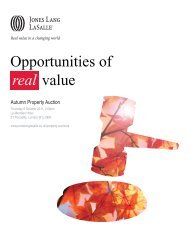
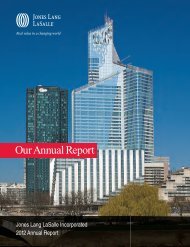



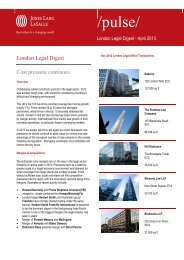
![Presseinformation inklusive Charts [PDF] - Jones Lang LaSalle](https://img.yumpu.com/23689734/1/184x260/presseinformation-inklusive-charts-pdf-jones-lang-lasalle.jpg?quality=85)
